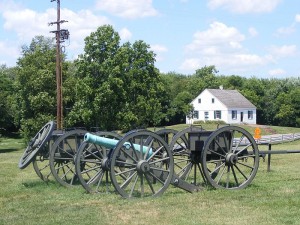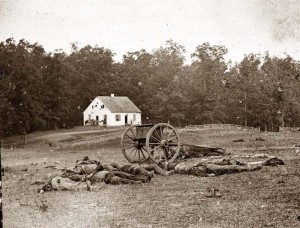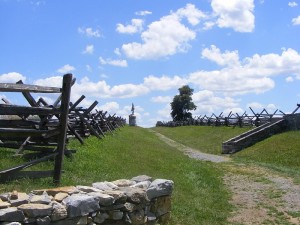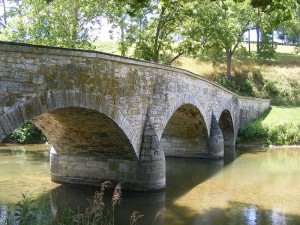I was asked by Patrick to write up a guest article about my recent trip to the Antietam National Battlefield in the Sharpsburg, MD area. I appreciate the opportunity to share my visit with his readers. In order to keep it short I will give a VERY brief overview of the battle and my thoughts about the battlefield and the sights and sounds that accompanied my visit.
It is September 16th, 1862 and Union General George B. McClellan and his Army of the Potomac are face to face with Confederate General Robert E. Lee and his Army of Northern Virginia. On the 17th, the single bloodiest day in American history, the two armies would attack and counterattack around Miller’s cornfield and Dunker church and finally culminate in the breaking of the Confederate line along the Sunken Road. However, with the advantage the Federals failed to follow-up and it was not until late in the day that Union General Ambrose Burnside finally got involved in the action, crossing the Antietam Creek and pushing the Confederate right flank. With what seemed like victory at hand, Confederate General A.P. Hill arrived from Harpers Ferry, VA. just in the nick of time to drive back Burnside and snatch victory from the Federals.
Overnight and thoughout the day of the 18th Lee would continue to skirmish with the Union Army while continuing to slowly pull his forces south of the river – McClellan and the Union Army would not continue the assault on the Confederates even though they outnumbered them three-to-one. The Confederate Army slipped back into the Shenandoah Valley and the battle ended in a draw. President Abraham Lincoln was NOT happy with McClellan and replaced him as commanding general with General Joseph “Fighting Joe” Hooker.
Over 23,000 men lost their lives during this battle in what could have potentially been the end to the Civil War.
The day I arrived at the battlefield it was bright and sunny, with a few puffy clouds in the sky and it was a nice and balmy 90+ degrees. We actually stopped along the way at what was McClellan’s headquarters, signal station and Union hospital, just off the road prior to even getting into the actual battlefield area. One thing that was really noticeable was the amount of markers and monuments that dotted the roadways and trails not only on the battlefield proper, but prior to getting there and as we were leaving. If you have ever been to the Chickamauga battlefield, which I thought had a LOT of markers and monuments, you would be surprised at how many more Antietam has.
The first stop was at the Visitor Center to pay the $6.00 fee for our vehicle (5 of us) and to get a map. We also stopped in the gift shop which, in all honesty, was as big as the entire visitor center tour area (which is kind of sparse compared to other visitor centers I have been to) so the kids could get a gift and I could get my patch (I get a patch from every Civil War battlefield I visit…just something I do). Just outside the Visitor Center you can see the cannons that sit across the street from Dunker Church, the site of some of the fiercest fighting.I took a picture to compare with the image from right after the battle to get a visual of where I was standing (as best I could remember):


We next drove north towards the East Woods area, which at the time ran all the way up to what is now Cornfield Ave but since the war had become farmland. It’s great to see that the folks at the battlefield are trying to preserve the place as best they can and have started planting trees again to repopulate areas that were cut down due to farming and return the area to it’s original look. The area north of Millers Cornfield was shutdown due to renovations, so unfortunately we were not able to see that area. There are lots of monuments and description markers along Cornfield Ave describing the action that took place between Hooker and Stonewall Jackson’s men.
We next drove north along the West Woods area, where in 20 minutes over 2,000 Union soldiers were killed or wounded and then headed back east towards the Mumma Farm, which was burned by Confederates to prevent the Union from using it for their sharpshooters. The house was was rebuilt a year after the battle and is what is standing today.

Next we drove along the long route south towards the Sunken Road (Bloody Lane). This is wide open field with rolling hills, a few trees and that natural depression that was the breastworks for the Confederate center. Standing there was a bit surreal. Remembering pictures and the stories of how the “dead were lined like railroad ties along the path” was humbling. As I was coming up to it I met two fellows from Long Island, NY who had been coming here since they were boys and they told me many “interesting” stories of how the battlefield has evolved over the years and even some tall tales of things such as finding bodies as recently as the 1960’s. While taken with a HUGE grain of salt, the two men obviously had a passion for the war in the east and to this site in particular. I love talking to others who share my passion for the period.
After that you are presented with majestic rolling fields, mountains that crest the horizon and absolutely beautiful landscape. It’s hard to believe so much carnage took place in such a beautiful place. We crossed route 34 that leads in from Sharpsburg from the west and Antietam creek to the east and made our way to the Lower Bridge (Burnside Bridge).

This area again is beautiful, but rather hilly and wooded. I can see why Burnside choose to attempt to cross the bridge here and fight it out rather than ford the not very deep Antietam Creek elsewhere. The observation deck to the bridge doesn’t give you much of a view and you really have to trek down to the bridge to appreciate it and what went on there. About 500 Confederates held the area for over three hours against Burnside’s soldiers, who eventually forced the Confederates back to the area of the final battle back towards Sharpsburg. The fields just west of the bridge is where Confederate General A.P. Hill arrived in the nick of time to save Lee and his army from destruction. However, as stated earlier, had McClellan realized his superior numbers and forced an assault the Confederates would most likely have been trapped between Burnside’s troops and main body of the Union Army.
I had a very rushed journey through the battlefield. We had been driving a couple hours from DC on our way back to Missouri, it was hot and the family was exhausted from a weeks worth of vacation. They slept in the van most of the time so I rushed and saw what I could as best I could. I spent two hours seeing what I saw and quite honestly, I did not even get close to skimming the surface of what Antietam holds for those interested in her stories. I plan on going back, with full battle analysis in mind and plenty of time to spare. To see the place in full and in detail would take you an entire day, two if you really wanted to get up close and personal and walk the trails. But this place is one of the beautiful remnants of our American heritage that is being well preserved not only by the National Park Service, but also by the people who visit it and the memories and stories that they take back with them. Like the two gentlemen who I met along the Sunken Road (who I ran into again at Burnside Bridge, and greeted me with a heavy New York accented yell of “Hey there Missouri!”) who have close, personal ties to the battlefield, Antietam is not only a place to remember the loss of life, the carnage and the heartache, but it is a place to remember that because of what happened there, it is one of the reasons we are a “United” States of America today.
I have many more pictures at my site Civil War in Missouri Information Site

I too, like my son, Nick, am a Civil War enthusiast. I’ve been wanting to visit Antietam but haven’t quite gotten there as yet. My vacations usually involve some type of Civil War monument or battlefield. This is a nice article without going into great detail, I hope you get lots of feedback on it. The pictures are awesome, Nick! Great job on those. I was really touched by the comment toward the end by the New Yorkers who said “Hey there, Missouri”. It was sooooooooooo like something out of the Civil War! Thanks for writing this up and letting your Facebook friends know about it.